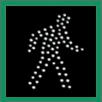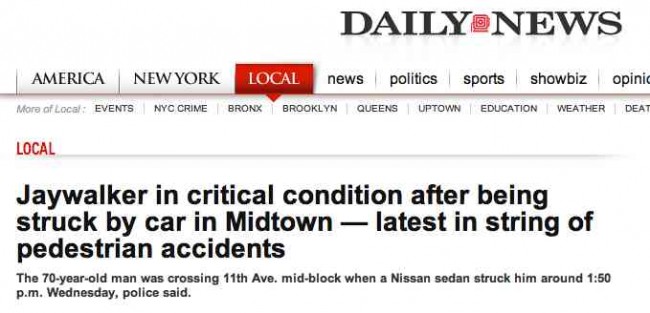As we entered the new era of “Vision Zero” , I started to exhale: I envisioned drivers who sped or refuse to yield would be ticketed with vigor. When NYPD Commissioner Bratton hired his broken windows consigliere, I was hoping for a crackdown on gridlocking and honking, two behaviors that are most emblematic of the lack of respect of the law and of others in our public space.
It would be an understatement to say that NYPD giving tickets to jaywalkers gave me pause: my emotions ran from despair at the thought of never changing NYPD, upset at being fooled by Bratton (what did I expect? he is coming from LA) , outrage at the “blame the victims” reaction.
The following week the Daily News blasted the word “jaywalker” in its headline, referring to a pedestrian injured in Hell’s Kitchen on 11th Avenue. This brought us back to the 1920’s when injuries and fatalities grew so numerous that some states considered imposing restrictions on the use of automobiles in cities. The auto industry coined that word to redirect the attention and instead criminalize the pedestrian.
And yet we should differentiate between those pedestrians and bicyclists injured and killed while they have the right of way, and those who jaywalk.
When pedestrians respect the rule, they expect others to do so as well. Essentially the logic goes that if they play within the system, the system will take care of the: streets are designed to protect them, the rules will be enforced and if everything else fails the system will be just and punish those that do not respect it. In truth, pedestrians have no choice: they cannot afford the same physical protections the manufacturers have given to the car driver; pedestrians have to trust the DOT engineers, the NYPD, the courts. And paradoxically, DOT engineers have been trained to design safe roads for cars, not pedestrians; NYPD does all its work in cars. So the system is ill-equipped to protect the pedestrian.
When someone jaywalks , tho person is clearly saying “I do not trust the system, the rules are not for me, I am taking things in our own hands”. Can you blame them? There are examples that could justify this behavior, where the risk-rewards are worth the try. Just go to Eighth Avenue at 5 p.m. and try to walk on the sidewalk! The good news is that – different from cars – the probability that such action by a pedestrian causes others to be injured or killed is utterly remote.
And even when jaywalking occurs, one should wonder why? For example, I always jaywalk to cross the narrow street in front of my house, where I can see cars coming, instead of crossing at the corner where I believe the danger of being hit by a car would be greater: in 2009, a 7-month pregnant woman was killed by a turning car, in the crossing while she had the walk sign . We are still waiting for a split phase there. On the other hand I consider it very dangerous to jaywalk across a two way street.
Do you remember this mother in Atlanta who was convicted of manslaughter because she crossed the highway and her child was killed? There was a bus stop, her house was across the wide thoroughfare but there was not a single crossing for another mile… Well on two-way streets there should be a pedestrian crossing in the middle of the long blocks similar to those on 34th , 42nd, 57th streets. And when MTA and DOT install a subway entrance in the middle of Broadway forcing pedestrians to cross two streets to get there, with cars turning at the same time, clearly the street design was at fault there.
This is why for me , Vision Zero should focus first and foremost on pedestrians and bicyclists who follow the rules. These people are real victims of a system that is broken . The street design is not appropriate and one of the parties, the most dangerous one (with a car), is not following the rules; the enforcement is not sufficient.
If the DOT engineers always chose to protect pedestrians over giving one more second of green light to cars, to install more crossings and install split phases at every intersection or at least on every two-way streets, and to give more sidewalk space to pedestrians , if the NYPD focused on gridlock, honking, speeding and yielding, the system would start to deliver what pedestrians expect: that the system is as safe as possible. And who knows , maybe fewer people would jaywalk, because finally they would trust the system.
See also the Savy New Yorker’s guide to Jaywalking

